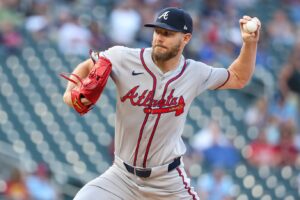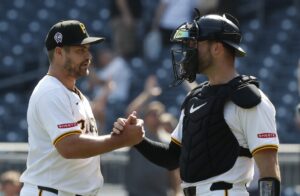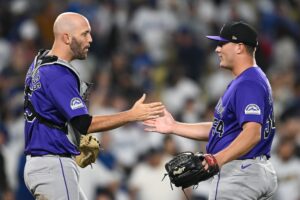The third installment of “Looking Back” will be about the greatest draft in MLB history. The 1985 MLB draft had three Hall of Fame players and two other players who should be in. Additionally, there are several players who had great careers. This draft had one of the best value picks and one of the best compensation picks of all time. Three prominent NFL players were also drafted but did not sign. All players would eventually play in the Major Leagues.
Best Value Pick Ever
John Smoltz had a very interesting career. Let’s look at his history. The first-ballot Hall of Fame pitcher could be the best value draft pick of all time. The Detroit Tigers drafted Smoltz out of Waverly High School in Lansing Michigan in the 22nd round with the 574th pick overall. That’s not a typo. The Tigers then traded their hometown kid to the Atlanta Braves for Doyle Alexander in 1987. Smoltz formed one part of the famous Braves big three starting pitchers while each year that trade would look worse and worse for the Tigers. Alexander did help the Tigers win the division but the eventual World Champion Minnesota Twins disposed of Motown in five games in the ALCS.
Smoltz would go on to play the bulk of his career in Atlanta and was arguably the best of the Braves big three. In 2000 Smoltz had Tommy John surgery and missed the entire season and part of the 2001 season. With his recent injuries and the Braves lack of a closer, this led him to becoming the stopper in Atlanta. Smoltz was the closer for three and a half seasons in Atlanta and saved 154 games including a NL record of 55 in 2002. For his career, Smoltzie went 213-155 with an ERA of 3.33 and a WHIP of 3.24. In 3,473 innings pitched Smoltz had 3,084 strikeouts. Smoltz has one Cy Young award and is the only pitcher in history to have 200 wins and 150 saves.
In the postseason Smoltz took his game to another level. Smoltz had a 15-4 record with four saves with a 2.67 ERA and a 1.144 WHIP. In 209 innings Smoltz struck out 199 batters. This is a full seasons worth of work which could win a CY Young in most years.
The Big Unit
This Hall of Fame pitcher won five Cy Young awards including four straight from 1999-2002. He also has won the award in both leagues. The Montreal Expos drafted Randy Johnson in the second round with the 36th overall pick. Johnson’s 22-year career saw him play for six different teams. The Expos traded him to the Seattle Mariners in a package for Mark Langston. He won his first Cy Young in 1995 with the Mariners. The Mariners traded him to the Houston Astros for prospects in 1998. Johnson was great in Houston leading them to the National League Central Division title but the San Diego Padres bounced them out of the playoffs in the NLDS three games to one.
Johnson would sign with the Arizona Diamondbacks for the 1999 season. The Big Unit’s legacy really was written as a member of the Diamondbacks with four straight Cy Youngs and a World Championship. He was traded to the New York Yankees and then back to the desert in Arizona before finishing his legendary career as a San Francisco Giant. Johnson went 303-166 with a 3.29 ERA and a 1.171 WHIP. In 4,135 innings Johnson struck out 4,875 batters including four straight seasons of over 300 punchouts. In the postseason Johnson went 7-9 with a 3.50 ERA and a 1.140 WHIP. Johnson struck out 132 batters in 121 innings. John Smoltz and Randy Johnson would enter the Hall of Fame as first-ballot electees together in 2015.
The Immortal One
Whether you like him or not Barry Bonds is one of the greatest players in the history of the game. The Pittsburgh Pirates drafted Bonds in the first round with the sixth overall pick. Bonds played seven seasons in the Steel City before signing with the Giants for the next 15 seasons. Bonds has won the MVP seven times including back to back seasons with two different teams. He won his first MVP in 1990 and his last one 14 years later in 2004. Bonds has eighth Gold Gloves, 12 Silver Slugger awards, and was a 14-time All-Star. In addition, Bonds has six MLB records and is second in WAR to only Babe Ruth.
Bonds has the MLB single-season record for HR with 73 in 2001 and the most in MLB history with 762. He also has the single-season record for walks with 232 in 2004 and owns the career mark with 2,558. Bonds has also been intentionally walked an absurd 688 times. He finished with a slash line of .298/.444/.507 and an OPS of 1.051. Bonds also scored 2,227 runs and stole 514 bases.
Bonds did struggle in his first five playoff appearances prior to the 2002 season. His performance in that year boosted his numbers to a better level but still not what we are accustomed to seeing from Bonds. In his postseason career Bonds slashed .245/.433/.503 with 9 HR and 24 RBI and 33 runs scored.
Barry Bonds is not in the Hall of Fame.
Best Player Not in Cooperstown
Bonds has been linked to PED use for many years. Despite never failing a drug test the perception is that he was on the juice. After all how many players can say they go from great to legendary at a point in their career when players start to slow down. Watching Bonds play during those years was like watching a video game. He could do anything he wanted at any time on the field.
No one knows for sure if Bonds was ever using PED’s but so far it has kept him out of the Hall of Fame. With two years of eligibility left Bonds has been slowly creeping towards the needed 75 percent of the votes to get into Cooperstown. PED’s or no PED’s the career numbers of Barry Bonds show that he is one of the greatest players of all time.
Queen City Boy
The third Hall of Fame player in this draft was actually drafted the highest but was not the best of the bunch. The Cincinnati Reds drafted local boy Barry Larkin with the fourth overall pick. Larkin gets lost in the shuffle compared to the likes of Smoltz, Johnson, and Bonds. But make no mistake Larkin is a great player. He has one MVP under his belt with three Gold Gloves and has won nine Silver Slugger Awards. Larkin also was a 12-time All-Star who played his whole 19-year career with the Reds.
You really need to put Larkin’s career in perspective. His rookie year was 1986 and Cal Ripken Jr. was already established as the best shortstop in the game. Larkin’s MVP season was 1995 which was midway through his career. In 1996 the new breed of shortstops started to take over. There was the big three of Alex Rodriguez, Derek Jeter, and Nomar Garciaparra and two years later Miguel Tejada burst onto the scene. At no point was Larkin ever considered the best at his position. But he ranks in the top ten of most major offensive statistics for shortstops that are in Cooperstown.
Larkin had a career slash line of .295/.371/.444 with 198 HR and 960 RBI with 1,329 runs scored. Larkin also stole 379 bases. In 17 career postseason games, Larkin slashed .338/397/.465 with three RBI and 11 runs scored.
Compensation Cubbie
Rafael Palmeiro was drafted in the first round with the 22nd pick by the Chicago Cubs. The Cubs received this pick from the Padres after they signed Tim Stoddard. This will go down as one of the greatest compensation picks of all time and Palmeiro is the second player from this draft who would be in the Hall of Fame if not for PED’s. Raffy was not only consistent he was consistently great and would have easily been a first-ballot Hall of Famer. Palmeiro never won an MVP but he was a four-time All-Star, a three-time Gold Glove winner, and won two Silver Slugger awards. Palmeiro played for the Cubs, Texas Rangers, and the Baltimore Orioles in a 20-year career.
For his career, Palmeiro slashed .288/.371/.515 and hit 569 HR with 1,835 RBI. Palmeiro also has 3,020 career hits which puts him in an elite club. Only six major league players in history have hit 500 HR and had 3,000 hits. Ironically one-third of this club will never be in Cooperstown.
BJ’s the One
The number one overall pick in this draft was William James B.J. Surhoff. He was drafted by the Milwaukee Brewers after playing for the University of North Carolina. Surhoff who was born in the Bronx in New York was drafted in the fifth round of the 1982 draft by the Yankees but opted to attend college. Surhoff did have a great career and he was a very consistent and solid major league player. But he will always be overshadowed by the tremendous talent this draft produced.
Surhoff’s strength as a player was in his versatility. He played every position except for pitcher. His career numbers are better than you think. His slash line is .282/.332/.413. Surhoff hit 188 career HR with 1,153 RBI, 2,326 hits, and 141 stolen bases. In Surhoff’s 19-year career he played for three different teams. He played nine seasons with the Brewers before spending five seasons with the Orioles. Surhoff then played three seasons in Atlanta before finishing his career back in Baltimore for three more seasons. In 2007 Surhoff was elected into the Orioles Hall of Fame. Surhoff also played well in a small sample of games in the postseason. In 27 career postseason games, Surhoff slashed .267/.295/.444 with four HR and 12 RBI.
Surhoff’s father Dick played in the NBA from 1952-1954 and his brother Rich Surhoff pitched for the Philadelphia Phillies and Rangers in 1985. He is also the uncle of Pirates third baseman Colin Moran and Toronto Blue Jays pitcher Brian Moran. The Moran brothers made history this past season when Brian making his major league debut for the Miami Marlins faced his brother Colin.
Notable Players
With five Hall Of Fame caliber players already in this draft let’s see what else this draft produced. The first round had other productive players. Will Clark was selected with the second overall pick by the Giants. Walt Weiss went 11th overall to the Oakland Athletics. The Boston Red Sox drafted Tino Martinez in the third round 75th overall but he did not sign. Two notable players were drafted in the fourth round. With the 85th pick, the Mariners drafted Bobby Thigpen and with the 94th pick, the Braves drafted David Justice. In the 10th round and the 257th pick, the Red Sox took Brady Anderson. If not for Smoltz, Mark Grace would be the steal of this draft. Grace was drafted in the 24th round with the 622nd pick by the Cubs.
Secondary Drafts
From 1966 through the 1986 season MLB had three other drafts. In January there were two secondary drafts for players who graduated in January. Additionally, there was a secondary draft in June which is when the regular draft is held. There are some familiar players taken in these drafts. In Phase 2 of the January secondary draft, the St Louis Cardinals drafted Todd Stottlemyre with the first overall pick. The third pick was Todd’s brother Mel Stottlemyre Jr. who was drafted by the Houston Astros. Chuck Finley was drafted 4th overall by the California Angels. Former closer John Wetteland was drafted in the second round and 39th pick overall by the Los Angeles Dodgers. All players would sign a contract except for Todd Stottlemyre. The Toronto Blue Jays drafted him third overall in the June Phase 2 draft later that year.
Vaughn Gets Drafted Again and Again
Greg Vaughn could have the major league record for most times getting drafted. Vaughn was drafted a whopping five times. It started in 1984 when the Cardinals took him in the fifth round of the January Phase 1 draft. The Brewers would then select him in the 4th round of the June Phase 2 draft. In 1985 the Pirates drafted Vaughn with the 19th overall pick in the January Phase 2 draft. The Angels would draft Vaughn in the third round of June Phase 2 draft. Finally, the journey ended for Vaughn when the Brewers took him with the 4th overall pick in the June Phase 2 draft in 1986.
Two Sport Stars
This draft also had its share of two-sport stars. These three players were drafted but did not sign. However, all three played baseball and football. The Kansas City Royals drafted Deion Sanders in the sixth round with the 149th pick. The Cleveland Indians drafted Brian Jordan in the 29th round with the 505th pick. The then California Angels drafted Vincent Edward Bo Jackson also in the 20th round with the 511th pick. All three players would eventually play professional baseball and football.
Dell Curry was drafted in the 14th round with the 39th pick by the Baltimore Orioles. Curry is the father of NBA star player Stephon Curry.
Please click on the link below for the first two installments of “Looking Back”
Main Image
Embed from Getty Images






